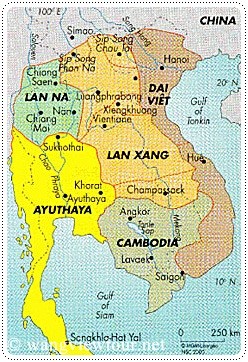
| |||||||||
|
History of Laos
"Introduction to Laos history
|
|||||||||

|
The Mon-Khmer kingdom in pre-Cambodia settled down in what is today south Laos. Between 8th to 12th century, the Mon-Khmer established further north all the way to Muang Sawa (today's Luang Prabang).
From 12th to 13th century, small Lao kingdoms were incorporated into the Angkor empire. This led to Lao and northern Thai rebellions. Then in 1238 the Sukhotai kingdom was established (Thai kingdom). Sukhotai kingdom incorporated areas of Luang Prabang, Vang Vieng and parts of today's north Thailand.
In the 13th century, a Lao prince called Chao Phi Fa was expelled by his father for sleeping with one of his wives. The son, Chao Fa Ngum, fled as a refugee to Angkor. Fa Ngum then married the Angkor king's daughter.
With Khmer troops, Fa Ngum seized Luang Prabang, which would be an important trading center afterward. They also seized parts of Thailand (Khorat).

|
After sitting on the throne for a while, Fa Ngum went to exile as a result of a coup arranged by his ministers. The ministers installed Fa Ngum's son - Oun Heuan - on the throne.
Luang Prabang was during this time not only an important trading center, but also center of Buddhism which became the state religion. A number of wats were built during this period.
But in the beginning of 1400s, struggles between factions began and would continue 100 years later.
1500s-1900 centuries

|
King Settathirat built the largest Buddhist stupa in Laos, which is called That Luang. That Luang remains the national symbol of Laos.
King Setthathirat disappeared in 1571 and Lao factions destabilized the country, and made it vulnerable to Burmese armies. The Burmese came and went several times over the next 60 years. This also led to the decline of Laos (Laos was called Lane Xang at that time).
In 1637, king Suriya Vongsa took the throne and ruled for almost 60 years. These years were peaceful and he recovered Laos' territories and power.
When Suriya died in late 1600s, Laos was split into factions again.
During the 1800s, Burma annexed Luang Prabang and Champasak (south Laos) was taken by Siam (today's Thailand) in 1778. By the end of 1800s, the Siamese was the dominating power in Laos.
Siam installed Lao prince Chao Anou as their vassal in Vieng Chan (today's Vientiane). But he got a taste of power and didn't follow the guidelines of his masters. He gave life to Lao culture and extended his influence to Luang Prabang. In 1820s, Chao Anou rebelled against his Siamese masters and invaded the northeast of Siam. But unfortunately, he was chased back to Vieng Chan.
The Lao-Siam war ended in 1828, and the Siamese control extended into the 1900s. The King of Luang Prabang agreed in the late 1800s to become a French protectorate.
The French had plans of annexing Siam, but failed. So the French eventually lost interest in Laos.
1900 and onwards

|
Because of the country's isolation and difficult terrain, Laos was never seen as profitable from a colonialist point of view. This would probably explain some of the slow growth in Laotian economy compared to its neighboring countries.
The Indochinese Communist Party (ICP) was established by Ho Chi Minh in 1930. During this time, the party recruited Laotians and the numbers grew. They even established a 'Laos section' inside the Party in 1936. This 'section' would eventually become the reigning government in Laos (LPRP). The ICP established the Laos Issara - a nationalist resistance movement.

|
During Second World War, the Thai with the help of the Japanese, occupied Laos. In 1944, France was liberated and this time it was Charles de Gaulle who came into power.
French armies were chased by the Japanese. The Japanese occupied Vientiane and Luang Prabang. Lao and French soldiers fought side by side against the Japanese, and there were a lot of casualties.
Later on the Japanese surrendered.
Laos became an independent country in 1953, and independence was declared by king Sisavangvong (main street in Luang Prabang bears his name).

|
So you can say that Laos has had some rough centuries.
In 1975 the king was forced to abdicate his throne and the Lao People's Democratic Republic was established. Since then, the Lao People's Revolutionary Party (LPRP) has been in control of the country. They signed a peace contract with the Vietnamese.
The LPRP isolated Laos and cut off trade with its neighboring countries except for Vietnam.
In the 1980s, Laos made some economical reforms and there has been some economical growth. The investment in the tourism industry was made in late 1990s, making Luang Prabang a UNESCO World Heritage site.
Today, Laos is still run by one of the few Communist governments in the world.
Return to top of History of Laos
Search this site
Learn Lao
Traveling in Laos? Learn Lao phrases for free!
 Learn Lao on your iPod
Learn Lao on your iPod
Connect with
Backpacking Tips Asia



